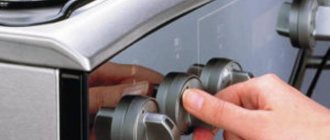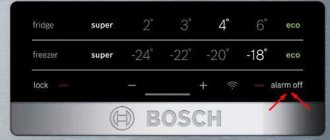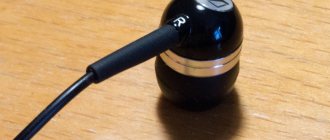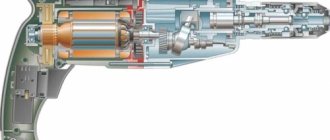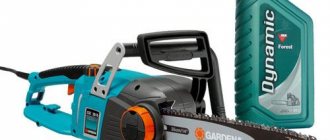In angle grinders (angle grinders), commonly called grinders, the main load falls on the gear reducer that changes the axis of rotation.
Care is required throughout the entire period of operation, since the mechanism needs to reduce friction between its interacting parts and timely maintenance.
The use of lubricant for the grinder gear allows not only to minimize the destructive frictional effect, but also helps to cool the tool.
When do you need to change the lubricant in an angle grinder?
The timing of the next lubricant change depends on the loads and intensity of use of the angle grinder. Usually it is 12 months. With everyday use of an angle grinder with frequent overheating, the frequency of shifts is significantly reduced, to at least six months.
To make sure that a new volume of lubricant needs to be added, the gearbox must be disassembled by unscrewing the screws on its cover. Inside there is a pair of helical gears.
The small one is located on the anchor and is used to drive the large one, located on the secondary shaft. A grinding or cutting disc is attached to this shaft.
During operation, the lubricant scatters along the walls of the housing as the gearbox moves, drying out over time and forming large lumps. The material used for a long time overheats, becomes liquid and flows out of the housing.
Therefore, its volume in the gearbox decreases. If there is only a thin layer of lubricant on the gears, additional lubricant is required.
The grease for the grinder must be changed if there are dried lumps on the inner walls of the gearboxes or if there is insufficient quantity.
Why lubricate the gearbox of an angle grinder?
During operation, the internal parts of an angle grinder experience significant friction, which causes wear. Small particles of metal are scraped off, dust gets into the gearbox, all this, as it accumulates, contributes to even greater wear and overheating. Lubrication of the gearbox is necessary primarily to reduce the coefficient of friction. It also improves heat dissipation and binds particles. In addition, lubricant increases the metal’s resistance to corrosion. Over time, depending on the frequency of use of the grinder, the lubricant loses its properties, and due to the large accumulation of solid inclusions, it can, on the contrary, increase the wear rate of rubbing pairs.
Tool manufacturers indicate in the technical documentation how often maintenance of the mechanism is required. However, the given time frames are quite subjective, since it all depends on how often the angle grinder is used and how dusty the air is in the room where the device is used.
How much grease is required for replacement
The required volume of lubricant for angle grinders is prescribed taking into account the complete coverage of the oblique teeth of the gears. Excess material will be squeezed out of the housing, and too little material will not ensure proper functioning of the gearbox.
It is recommended to take as a guide the amount of lubricant provided when the machine was assembled at the factory. It should be taken into account that during long-term storage in a warehouse or store, a certain amount of lubricant may dry out and decrease in volume.
Therefore, it is better to first put a little more material than required and make sure that the lubricant is evenly distributed after the gearbox gears are driven into action. The generally accepted norm is to fill about 40% of the gearbox volume with lubricant.
How to properly lubricate an angle grinder
Lubrication of the grinder gearbox is carried out in several stages.
Old grease removal stage
Removing used grease is the first stage of gearbox maintenance. It is necessary to remove the old layer for several reasons:
- the used lubricant is not able to perform its functions;
- it contains small particles formed during the wear of rubbing elements;
- The old lubricant will mix with the new one, because of this the unit will not work correctly, and replacement will not bring any results.
VIEW Gearbox lubricants on AliExpress →
Removal of waste is carried out using disposable paper towels, rags, or a piece of fabric at hand. The removed gearbox parts should be thoroughly washed in solvent or gasoline and dried before installation.
Residues from cleaning materials can also mix with the new lubricant and change its consistency, resulting in poor performance.
Stage of applying lubricant to the bearing
Gear bearings should be lubricated, filling all available free spaces. The lubricant is squeezed out of the tube until its excess flows out from the back side - this serves as an indicator of the required filling level.
Stage of applying lubricant to the gearbox
The gearbox must be filled with such a volume of lubricant that it completely covers the gears.
Monitoring the sufficiency of lubrication for the angle grinder gearbox is carried out by turning on the grinder for a short period of time. If within 3–5 minutes of operation the temperature of the unit has increased and lubricant leakage is observed, part of its volume must be removed. To do this, the gearbox is disassembled again, the excess is removed with a rag or cloth.
When checking, the opposite situation may be observed when noise appears when the angle grinder is turned on. This means that there is not enough lubricant and it needs to be added.
When using an angle grinder, periodic checking of the sufficiency of lubrication of the gearbox elements and the quality of the available lubricant is required.
To carry out preventive inspections, it is necessary to unscrew the bolts holding the cover together and visually inspect each part. If slightly dry or completely dry areas are observed, a complete replacement of the lubricant is recommended.
VIEW Gearbox lubricants on AliExpress →
Lubricants recommended by foreign tool manufacturers
Foreign tool manufacturers, including angle grinders, recommend specially developed ointments as lubricants for angle grinders.
One of the most common foreign lubricants is the lubricant marked MoS2 NLGI 2 ISOL-XBCHB 2 DIN 51825-KPF 2 K-20.
Let's decipher the marking:
- MoS2 – indicates the filler material, in this case molybdenum;
- NLGI2 - indicates the second viscosity class;
- ISOL-XBCHB 2 – belonging to ISO standards;
- DIN 51825-KPF 2 K-20 – lubricant manufactured according to German DIN standards;
- The numbers 51825 mean that the lubricant is type K.
Lubricants produced with such characteristics are quite expensive. There are imported, less expensive lubricants on the Russian market.
Every tool manufacturer, be it Bosch, Makita, Hitachi, DeWalt, Metabo, RedVerg, Interskol, E256, LEPSE, recommends its own lubricants. This is the manufacturer's policy. They insist that when performing maintenance, the lubricants specified in the instructions must be used. Moreover, failure to comply with these recommendations does not allow warranty repairs to be performed.
Lubricant for the Makita angle grinder gearbox is available in tubes. Its high cost is commensurate with its high quality and long service life.
Which lubricant to choose
There are several ways to reduce the frictional impact on the interacting elements of an angle grinder gearbox. The choice of how to lubricate friction units is made from the following options:
- the use of expensive special lubricants for gearboxes from well-known brands;
- the use of universal compounds suitable for any power tool;
- lubricating the gearbox with lithol or grease;
- use of self-made lubricant.
Application of special materials is the optimal solution. When choosing a lubricant for a gearbox, it is recommended to give preference to compounds produced under the same brand as the grinder itself. For example, if the machine is an AEG brand, then the lubricant must be purchased from the same brand.
When using specialized products, the service life of angle grinders increases significantly, since the manufacturer takes into account all the features and nuances of operating its own equipment. The disadvantage of using branded materials is their high cost, which can affect the family budget.
VIEW Gearbox lubricants on AliExpress →
Most craftsmen use budget grinders or tools made in China. For such machines, specialized lubricating compounds have not been developed by the manufacturer and are unlikely to ever appear. However, such equipment also requires maintenance. What to do in this case?
Specialists and service technicians recommend purchasing any budget, non-branded compound designed specifically for gearboxes. You can also use a lubricant used for CV joints, the joint of front-wheel drive vehicles that operate under significant loads.
It can be purchased without any problems at any auto store. This option is much worse than using branded materials. This is due to the fact that the specifics of the operation of friction units of two different mechanisms are not taken into account.
The most unfavorable solution is the use of lithol or grease, since both of these materials are not designed to lubricate friction units that heat up to high temperatures.
Some owners of grinders use only these compounds, which is why their machines cannot last the service life declared by the manufacturer. In an effort to benefit here and now, they do not take into account the future costs of purchasing a new tool or replacing expensive parts.
Ready-made lubricants
As a rule, the manufacturer requires customers to use only products of their brand to lubricate the gearboxes of an angle grinder. And this is quite understandable. All lubricants undergo rigorous tests directly at the company’s factory. The manufacturer selects the composition and manufacturing technology in such a way as to obtain a product that maximizes the service life of parts. At the same time, lubricants from tool manufacturers also have a drawback - high price.
Instead of oils directly from the manufacturer, it is quite possible to use high-quality alternatives. In this case, you should carefully read the required properties that the manufacturer described in the instructions for the grinder. Several popular alternative brands of lubricants: Haskey, Castrol, Liqui Moly, as well as the domestic offer “Nanotech”.
It is better to lubricate a device whose warranty period has not yet expired with a branded product. Otherwise, if the angle grinder breaks down, you may be denied repairs at the seller’s expense.
Homemade mixtures
Situations when there is an urgent need to lubricate the elements of an angle grinder are not uncommon.
And at the same time, as luck would have it, there is no way to get a lubricant suitable for these purposes. Then the owner can try to make the product with his own hands from available materials. To ensure the required level of adhesion, lubricant for automobile CV joints is used as a basis. In addition to its excellent penetrating properties, it can be used for operation in the following conditions:
- significant loads;
- high humidity;
- temperature fluctuations over a wide range;
- significant heating;
- exposure to solid pollutants.
To liquefy the material and obtain the consistency required for the gearbox, it is recommended to add MS-20 oil. The liquid is introduced into the base gradually, preferably in drops, with constant stirring of the resulting composition with a mixer.
No less effective is the use of homemade material based on Cythiam-221 with the addition of TAD-17.
What gear lubricant do you use? Have you ever made your own lubricant? Share your experience with us, please.
Homemade lubricants
If desired, you can make your own lubricant for angle grinders. To do this, you will need a grease, for example CIATIM-221, oil (I-20 is suitable), as well as a suitable metal container for mixing and a burner.
The manufacturing process is generally simple, but obtaining a uniform product is very difficult. Oil is added to the grease with constant mixing and slow heating. If successful, a stable connection between the two components should be obtained.
In any case, the quality of the finished composition will be low, and it should not be used for long-term work.
